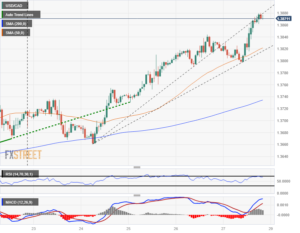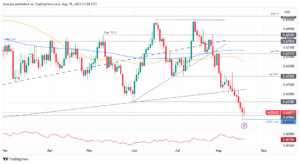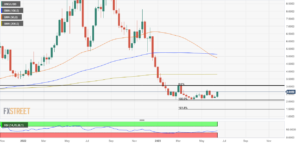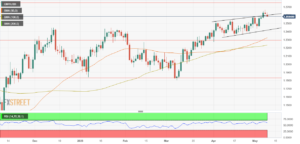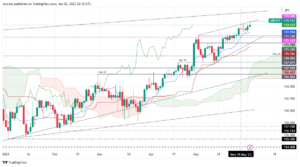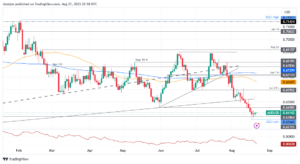
- Gold price finds an interim support ahead of the US inflation data.
- The US headline and core inflation grew by 0.2% and 0.3% respectively in December.
- The likelihood of a rate cut by the Fed from March has eased due to solid labor market conditions.
Gold price (XAU/USD) recovered on Wednesday after a slight fall in 10-year US Treasury yields as investors shift focus towards the United States inflation data for December, which will be released on Thursday. The recovery in the Gold price is expected to remain short-lived as investors’ confidence that the Federal Reserve (Fed) will start cutting interest rates from March has been shaken. This is due to upbeat labor market conditions and the fact that core Consumer Price Index (CPI) is double the desired rate of 2%.
Fed policymakers have been supporting a tighter monetary policy stance and endorsing interest rate cuts in the second-half this year, until they are more confident that inflation will return to 2%. Furth action in bullions and safe-haven assets will be guided by the US inflation data. A softer-than-anticipated inflation report will boost hopes in favour of rate cuts from March – supporting the Gold price – while escalated numbers could build more stress.
Daily Digest Market Movers: Gold price recovers while US Yields face pressure
- Gold price aims for a firm-footing around $2,030 after two-weeks of decline as US Treasury Yields have dropped ahead of the United States inflation data for December.
- The 10-year US Treasury yields have slipped to near 4.04% as inflation data is eyed.
- The upside in the precious metal is expected to remain restricted as investors are expected to wait before taking informed decisions post release of the inflation data.
- The precious metal remained under pressure lately as investors cut bets in favour of rate cuts by the Federal Reserve from March due to healthy labor market conditions and the core inflation remaining double the required rate of 2%.
- As per the CME Fedwatch tool, the chances of Fed reducing interest rates by 25 basis points (bps) to 5.00-5.25% have dropped to 63% from 90% a week earlier.
- Apart from that, Fed policymakers are leaning towards a restrictive interest rate stance until price stability gets ensured.
- This week, Atlanta Fed Bank President Raphael Bostic said he is naturally biased towards a tight monetary policy stance until he is sure that the underlying inflation will return to 2% before supporting rate cuts.
- Raphel Bostic sees the first interest rate cut coming in the third quarter and two quarter-percent rate cuts due in the final quarter this year.
- Meanwhile, the US Dollar Index (DXY) trades topsy-turvy around 102.50 ahead of the US inflation data.
- As per the consensus, the monthly headline inflation is expected to have grown at a higher pace of 0.2% against 0.1% increase in November. In the same period, the core CPI that strips off volatile food and Oil prices is seen rising steadily by 0.3%.
- Annually, the headline inflation is forecast to have accelerated to 3.2% against 3.1% growth in November while the core inflation softened to 3.8% vs. the former reading of 4.0%.
- A sticky inflation report may result in a further decline in the chances Fed policymakers will roll back their restrictive monetary policy stance while moderate numbers could boost hopes of rate cuts from March.
- Before the US inflation data, investors will focus on the speech from New York Federal Reserve President John Williams. The Gold price could face more pressure if Williams joins Raphael Bostic in support of waiting till the end of the year before making rate cuts.
Technical Analysis: Gold price aims sustainability above $2,030
Gold price has corrected more than 3% from 28 December 2023 high around $2,090 as uncertainty over rate cuts by the Fed continues to persist. The near-term demand for the Gold price is not bullish anymore as the 20-day Exponential Moving Average (EMA) around $2,038 is acting as a strong barrier. While the broader trend is still bullish as the 50-and 200-day EMAs are sloping higher. More downside could appear if the yellow metal drops below three-week low around $2,016.
Gold FAQs
Gold has played a key role in human’s history as it has been widely used as a store of value and medium of exchange. Currently, apart from its shine and usage for jewelry, the precious metal is widely seen as a safe-haven asset, meaning that it is considered a good investment during turbulent times. Gold is also widely seen as a hedge against inflation and against depreciating currencies as it doesn’t rely on any specific issuer or government.
Central banks are the biggest Gold holders. In their aim to support their currencies in turbulent times, central banks tend to diversify their reserves and buy Gold to improve the perceived strength of the economy and the currency. High Gold reserves can be a source of trust for a country’s solvency. Central banks added 1,136 tonnes of Gold worth around $70 billion to their reserves in 2022, according to data from the World Gold Council. This is the highest yearly purchase since records began. Central banks from emerging economies such as China, India and Turkey are quickly increasing their Gold reserves.
Gold has an inverse correlation with the US Dollar and US Treasuries, which are both major reserve and safe-haven assets. When the Dollar depreciates, Gold tends to rise, enabling investors and central banks to diversify their assets in turbulent times. Gold is also inversely correlated with risk assets. A rally in the stock market tends to weaken Gold price, while sell-offs in riskier markets tend to favor the precious metal.
The price can move due to a wide range of factors. Geopolitical instability or fears of a deep recession can quickly make Gold price escalate due to its safe-haven status. As a yield-less asset, Gold tends to rise with lower interest rates, while higher cost of money usually weighs down on the yellow metal. Still, most moves depend on how the US Dollar (USD) behaves as the asset is priced in dollars (XAU/USD). A strong Dollar tends to keep the price of Gold controlled, whereas a weaker Dollar is likely to push Gold prices up.
- SEO Powered Content & PR Distribution. Get Amplified Today.
- PlatoData.Network Vertical Generative Ai. Empower Yourself. Access Here.
- PlatoAiStream. Web3 Intelligence. Knowledge Amplified. Access Here.
- PlatoESG. Carbon, CleanTech, Energy, Environment, Solar, Waste Management. Access Here.
- PlatoHealth. Biotech and Clinical Trials Intelligence. Access Here.
- Source: https://www.fxstreet.com/news/gold-price-aims-for-a-firm-footing-as-us-inflation-data-looms-202401101004
- :has
- :is
- :not
- $UP
- 1
- 102
- 2%
- 2022
- 2023
- 25
- 28
- 33
- 50
- a
- above
- accelerated
- According
- acting
- Action
- added
- After
- against
- ahead
- aim
- aims
- also
- an
- analysis
- and
- Animate
- any
- anymore
- apart
- appear
- ARE
- around
- AS
- asset
- Assets
- At
- Atlanta
- average
- back
- Bank
- Banks
- barrier
- basis
- BE
- been
- before
- began
- below
- Bets
- biased
- Biggest
- Billion
- boost
- both
- broader
- build
- Bullish
- buy
- Buy Gold
- by
- CAN
- central
- Central Banks
- chances
- China
- CME
- coming
- conditions
- confidence
- confident
- Consensus
- considered
- consumer
- content
- continues
- controlled
- Core
- core inflation
- corrected
- correlated
- Correlation
- Cost
- could
- Council
- country’s
- CPI
- currencies
- Currency
- Currently
- Cut
- cuts
- cutting
- data
- December
- decisions
- Decline
- deep
- delivers
- Demand
- depend
- desired
- Digest
- diversify
- Doesn’t
- Dollar
- dollar index
- dollars
- double
- down
- downside
- dropped
- Drops
- due
- during
- Dxy
- Earlier
- economies
- economy
- EMA
- emerging
- enabling
- end
- Endorsing
- ends
- ensured
- escalate
- exchange
- expanded
- expected
- exponential
- exponential moving average
- Face
- fact
- factors
- Fall
- FAQ
- favor
- fears
- Fed
- Federal
- federal reserve
- final
- finds
- First
- Focus
- food
- For
- Forecast
- Former
- from
- further
- geopolitical
- Gold
- gold price
- Gold Prices
- good
- Government
- grew
- grown
- Growth
- guided
- Have
- he
- headline
- healthy
- hedge
- High
- higher
- highest
- history
- holders
- hopes
- How
- HTTPS
- if
- improve
- in
- Increase
- increasing
- index
- india
- inflation
- informed
- instability
- interest
- INTEREST RATE
- Interest Rates
- interim
- investment
- Investors
- Issuer
- IT
- ITS
- jewelry
- John
- Joins
- jpg
- Keep
- Key
- labor
- labor market
- likelihood
- likely
- Low
- lower
- major
- make
- Making
- March
- Market
- market conditions
- Markets
- May..
- meaning
- medium
- medium of exchange
- metal
- moderate
- modest
- module
- Monetary
- Monetary Policy
- money
- monthly
- more
- most
- move
- Movers
- moves
- moving
- moving average
- Near
- New
- New York
- November
- numbers
- of
- off
- Oil
- on
- or
- over
- Pace
- per
- perceived
- period
- plato
- Plato Data Intelligence
- PlatoData
- played
- points
- policy
- policymakers
- Post
- Precious
- president
- pressure
- price
- Prices
- purchase
- Push
- Quarter
- quickly
- rally
- range
- Rate
- Rates
- Reading
- recession
- records
- Recovers
- recovery
- reducing
- release
- released
- rely
- remain
- remained
- remaining
- report
- required
- Reserve
- reserves
- respectively
- restricted
- Restrictive
- result
- return
- Rise
- rising
- Risk
- risk assets
- Role
- Roll
- Said
- same
- seen
- sees
- shift
- shine
- since
- solid
- Solvency
- Source
- specific
- speech
- Stability
- stance
- start
- starts
- States
- Status
- steadily
- sticky
- Still
- stock
- stock market
- store
- store of value
- strength
- stress
- strong
- such
- support
- Supporting
- sure
- Sustainability
- taking
- tend
- tends
- than
- that
- The
- the Fed
- the world
- their
- they
- Third
- this
- this year
- thursday
- tighter
- till
- times
- to
- tool
- towards
- trades
- Treasuries
- treasury
- Treasury yields
- Trend
- Trust
- turbulent
- Turkey
- two
- Uncertainty
- under
- underlying
- United
- United States
- until
- upbeat
- Upside
- us
- US Dollar
- US Dollar Index
- us inflation
- us treasuries
- US Treasury
- US treasury yields
- US yields
- Usage
- USD
- used
- usually
- value
- volatile
- vs
- wait
- Waiting
- weaker
- Wednesday
- week
- weighs
- when
- whereas
- which
- while
- wide
- Wide range
- widely
- will
- Williams
- with
- world
- World Gold Council
- worth
- XAU/USD
- year
- yearly
- yellow
- yields
- york
- zephyrnet

